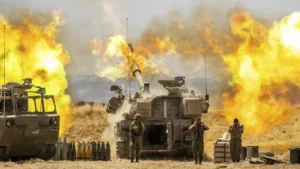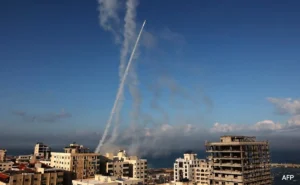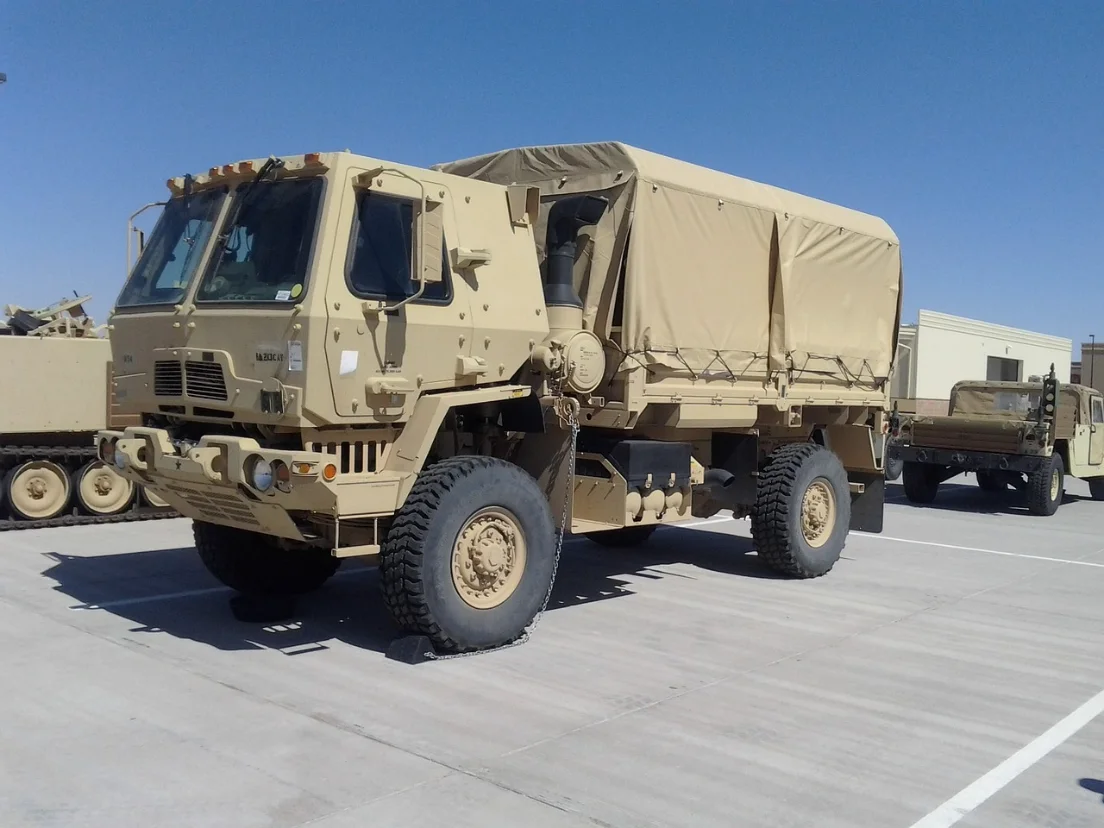In Tel Aviv, on Sunday, the Israeli military took action against Hamas militants from Gaza who had launched an unprecedented attack. Israel was facing a challenge in regaining control of its southern area and securing its borders.
Hamas, which is supported by Iran, stated that it had sent more fighters and weapons into Israel and subsequently launched another round of missile attacks from Gaza. Gaza is a densely populated coastal region that has been isolated for a long time. In the meantime, the Israeli military engaged in gunfire in southern Lebanon with Hezbollah, which raised concerns about the possibility of a second conflict involving Iran-backed groups.
Israel’s military and security forces were caught off guard when Gaza militants launched an invasion by air, land, and sea on Saturday morning. This invasion by Hamas extended as far as the city of Ofakim, which is over 20 miles inside Israel, after crossing nearly a third of the country’s width.

Since the fighting began, more than 500 Israelis have lost their lives, and 2,408 have been injured, according to Israeli army radio. On the Palestinian side, there have been at least 313 deaths and 2,000 injuries in the Israeli counterattacks on Gaza, as reported by the Palestinian Health Ministry. It’s unclear how many of the Palestinian casualties were militants, but Israel’s military has claimed it has killed many of them.
Israeli soldiers worked tirelessly overnight to remove militants from towns and villages in the desert areas of Israel. This came after Hamas made advances into a significant portion of territory, even infiltrating at least four military bases along the separation barrier with Gaza. The Israeli military is still in the process of searching for militants after regaining control of 29 areas. They also have plans to evacuate Israeli communities near Gaza in anticipation of a strong military response.
“This is going to be a lengthy and challenging situation,” stated Richard Hecht, a spokesperson for the Israeli military. Israel has already started launching airstrikes, targeting Hamas leaders and militants. The army has shared videos of these strikes, showing attacks on vehicles, Palestinian militants, and other targets.

The initial Israeli airstrikes have led to the destruction of over a dozen buildings in Gaza, with more than 1,200 residential units partially damaged, according to Salama Marouf, a spokesperson for Hamas.
Previous Israeli operations in Gaza have caused extensive damage, but the current response is made more complex by the hostage situation that arose during Saturday’s raids. Abu Obeida, the spokesperson for Hamas’s armed wing (which governs Gaza), announced that they had captured numerous individuals, including Israeli army officers, and dispersed them throughout Gaza. They issued a warning to Israel, urging them “not to make any rash decisions.”
The Israeli military, on the other hand, reported that soldiers and civilians had been taken captive and brought into Gaza, with a majority of their casualties resulting from close-quarters combat with Hamas.
Despite early diplomatic efforts to calm the situation, such as phone conversations between U.S. Secretary of State Antony Blinken and regional counterparts, they have not succeeded. Egyptian officials reported that their negotiators were unable to persuade Palestinian factions to release injured Israeli captives.

The wide-ranging Palestinian attacks, which began during the Jewish holiday of Simchat Torah, pose a threat to the ongoing U.S.-brokered talks aimed at normalizing relations between Saudi Arabia and Israel. President Biden expressed solidarity with Israel on Saturday, affirming that the U.S. is prepared to provide appropriate support.
This conflict arises during a period of significant domestic political turmoil in Israel. The nation is divided over a plan put forth by Prime Minister Benjamin Netanyahu and his far-right allies to diminish the authority of the country’s Supreme Court.
Netanyahu is in talks with opposition leaders about creating a unity government in response to the escalating situation. The military is calling up reservists, and the citizens are being prepared for further conflict.

In a Saturday-night address to the nation, Netanyahu stated, “What occurred today in Israel is unprecedented, and I am committed to preventing it from happening again. We are facing challenging days ahead, but we are determined to emerge victorious.”
Later on, he posted on social media, mentioning that Israel had initiated an offensive and is determined to continue until they achieve their objectives.
The Israeli military has calculated that around 3,500 rockets have been launched from Gaza. In response, anxious Israelis took shelter in safe rooms and bomb shelters. Throughout the night in Tel Aviv, you could hear explosions as the Iron Dome air-defense system intercepted rockets, although some did manage to hit the city, causing injuries to civilians.
On Sunday, Tel Aviv saw schools, cafes, and gyms closed. Thousands of Israelis queued up to donate blood. There’s an overwhelming sense of shock and grief, with many comparing the situation to their version of 9/11.
Meanwhile, in Gaza, approximately 20,000 Palestinians fled their homes, anticipating a broader Israeli retaliation. Some sought refuge in schools and emergency shelters.
Richard Hecht, the Israeli spokesperson, mentioned that the military is currently waiting for instructions from the government regarding the potential for a ground invasion. He also noted that while civilians won’t be evacuated from the territory (which is roughly twice the size of the District of Columbia), they may be requested or even compelled to relocate from specific areas depending on the military’s operational requirements.
In the West Bank, Israel has closed major roads and entry points, including those leading to neighboring Jordan. This has resulted in the isolation of the three main regions within this Palestinian territory, with additional checkpoints being set up.
The violence has now spread to nearby countries.
In Lebanon, Hezbollah claimed responsibility for using mortars and a guided missile to target three locations in the Israeli-occupied Shebaa Farms, which included a radar station. In response, the Israeli military used a drone to strike Hezbollah infrastructure nearby.
Fortunately, there were no reported casualties, and there’s no immediate sign of an escalation in the situation in that area.
Richard Hecht, an Israeli spokesperson, advised Hezbollah to refrain from getting involved, saying, “We recommend Hezbollah not to come into this. I don’t think they will. If they do, we are ready.”
In a separate incident, in the Egyptian coastal city of Alexandria, a police officer shot and killed two Israelis and an Egyptian at a tourist site. Egyptian security officials believe this was an isolated event.
Tensions along the Gaza-Israel border have been building up in recent weeks. Palestinians have been sending balloons with incendiary devices, and the Israeli military has responded with airstrikes. However, there were no signs of an imminent large-scale conflict. After the recent incursion into Gaza, Hamas leaders pointed to longstanding tensions between Israel and the Palestinians, which include disputes over access to holy sites in Jerusalem.
Israel’s military has had periodic clashes with Hamas, which the U.S. regards as a terrorist organization, since Hamas took control of the Gaza Strip in 2007 after a violent conflict with Fatah, the political group governing the Palestinian Authority. In May, Israel and another U.S.-designated terrorist organization in Gaza, Palestinian Islamic Jihad, exchanged fire for five days.
In the past few years, Israel’s approach towards Gaza has been to prevent a full-blown war by occasionally launching attacks on militant groups while tightly controlling the movement of people and goods into and out of the area. The last time Israeli ground troops entered Gaza was back in 2014.
In a recent strategic briefing, the Israeli military characterized the Gaza Strip as experiencing a state of “stable instability.” They claimed that Israel could use various economic measures to help maintain a semblance of calm. However, human-rights organizations argue that Israel’s extensive restrictions essentially confine Gaza’s two million residents in what amounts to an open-air prison.





